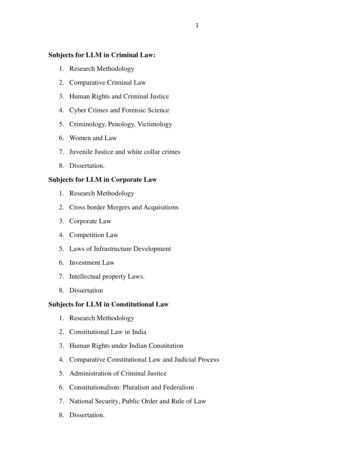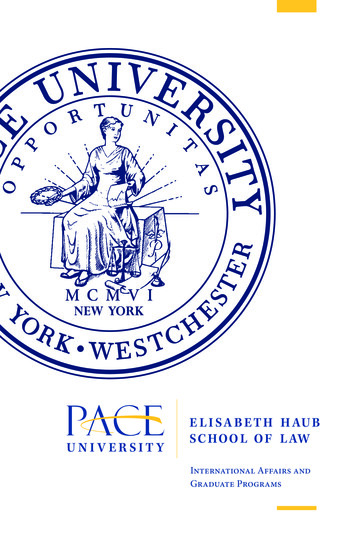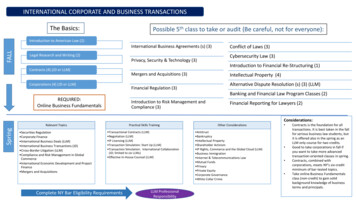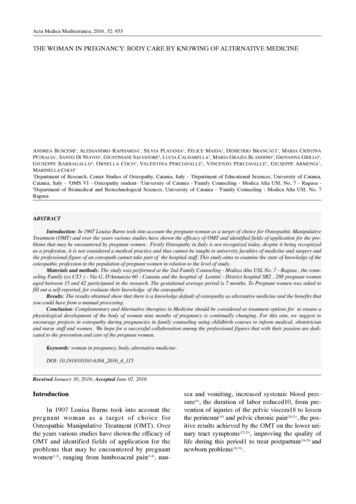
Transcription
1Subjects for LLM in Criminal Law:1. Research Methodology2. Comparative Criminal Law3. Human Rights and Criminal Justice4. Cyber Crimes and Forensic Science5. Criminology, Penology, Victimology6. Women and Law7. Juvenile Justice and white collar crimes8. Dissertation.Subjects for LLM in Corporate Law1. Research Methodology2. Cross border Mergers and Acquisitions3. Corporate Law4. Competition Law5. Laws of Infrastructure Development6. Investment Law7. Intellectual property Laws.8. DissertationSubjects for LLM in Constitutional Law1. Research Methodology2. Constitutional Law in India3. Human Rights under Indian Constitution4. Comparative Constitutional Law and Judicial Process5. Administration of Criminal Justice6. Constitutionalism: Pluralism and Federalism7. National Security, Public Order and Rule of Law8. Dissertation.
2SUBJECT: RESEARCH METHODOLOGYRESEARCH METHODS & LEGAL WRITINGThe main objective of this course is to acquaint the student of law with the scientific method of socialscience research. This course is expected to provide the knowledge of the technique of selection,collection and interpretation of primary and secondary data in socio legal research.Emphasis would be laid on practical training in conducting research in this course. By the end of thecourse the students are expected to develop a scientific approach to socio legal problems. They should beable to design and execute small scale research problems. The practical skill in conducting research willbe evaluated on their performance in field research and workshops/seminars.1. INTRODUCTION2. a) The science of research and scientific methodology3. b) Interrelation between speculation, fact and theory, building some fallacies of scientificmethodology with reference to socio legal research4. c) Inter-disciplinary research and legal research models5. d) Arm chair research vis-a-vis empirical research6. e) Legal research-common law and civil law legal systems7. RESEARCH DESIGN8. a) Workable Hypothesis-formulation and evaluation9. b) Major steps in research designIII. RESEARCH TECHNIQUES1. a) Sampling2. b) Survey and Case Study method
33. c) Scaling and Content Analysis1.2.3.4.5.6.7.RESEARCH TOOLS AND DATA PROCESSINGa) Observationb) Interview and schedulec) Questionnaired) Socio-metrics and jurimetricse) Data processing (deductions and Inductions) analysis and interpretation of dataf) Online Legal Research – Use of Electronic Databases1.2.3.4.5.6.LEGAL WRITINGa) Report/Article writing & legal researchb) Use of definitions, maxims, concepts, principles, doctrines in legal researchc) Plagiarism & its consequences.d) Citation methodologye) Book review and case commentsSuggested Reading Materials for Reference1.2.3.4.5.6.7.Robert Watt- Concise book on Legal ResearchGood and Hatt- Research MethodologyPauline Young- Research MethodologyEarl Babbie- Research MethodologyStott D.-Legal ResearchRobert Watt and Francis Johns- Concise Legal ResearchS.K. Verma&Afzal Wani- Legal Research Methodology
4SUBJECT: COMPARATIVE CRIMINAL LAWLLM IN CRIMINAL LAWOBJECTIVE OF THE COURSEThe objectives of this course are:1. To understand the conditions under which individuals should be held morally and legally responsible for their (criminal)actions;2. To understand whether or not there are any "fundamental principles" which underlie all criminal justice systems;3. To understand the issues concerning the merits or otherwise of codification in both the common law and the civil law, thebasic characteristics of criminal procedure under the inquisitorial and the adversarial systems, be aware of the relationship betweensubstantive criminal law and criminal procedure in relation to issues such as the principles of territoriality, equality before thelaw including the right to a fair trial, and the right to legal representation in the civil and common law systems;4. In-depth knowledge of the theoretical and practical international instruments for the prevention and punishment ofinternational and transnational crimes as well as of acts of terrorism. This includes a real time analysis of the activities of theinternational criminal jurisdictions: international criminal tribunals, International Criminal Court and special courts;5. Understanding the difference and similarities between various systems administering Criminal Justice.6. To understand specific competencies in the field of International Criminal Law;TEACHING METHODOLOGYAs per the norms of the university there will be 4 theory classes per week. Teaching Methodology will include Lecture-cum-
5case discussion, CRE, Assignments / Projects, and Presentations.THE EVALUATION SYSTEM Continuous Assessment.ProjectsEnd Term30 %20%50 %COURSE OUTLINEMODULE 1: - LEGAL CULTURES AND CRIMINAL JUSTICE POLICE Common LawCivil LawSocialist LawIslamic LawRecommended Readings:1. Francis Pakes, Comparative Criminal Justice, Willan Pub., Cullompton, 20032. M.A. Dupont-Morales, Michael K Hooper & Judi Schmidt (eds), Handbook of Criminal Justiceadministration, Marcel Dekker Publishers, New York, 20013. Tim Newburn and Richard Sparks (eds), Criminal Justice and Political Cultures, Willan Pub.,Cullompton, 20044. Hannah Arendt, Eichmann in Jerusalem: A Report on the Banality of Evil, Penguin Pub., London,20065. Alison Liebling and Shad Maruna (eds), The Effects of Imprisonment, Willan Pub., Cullompton,2006Articles:1. David F. Forte, Comparative Criminal Law and Enforcement: Islam, Encyclopedia of Crime andJustice, New York, 2002 pp. 192-1992. US Department of Justice, World Factbook of Criminal Justice Systems, Bureau of JusticeStatistics, Washington DC, 1993MODULE 2 ASPECTS OF COMPARATIVE CRIMINAL POLICY,
6Systems of Administration of Criminal Justice (Adversarial & Inquisitorial)Policing and ProsecutionTrials and SentencingUse of ImprisonmentProbation and Community PunishmentRecommended Readings:1. Charles B. Fields and Richter H. Moore, Comparative and International Criminal Justice:Traditional and Nontraditional Systems of Law and Control, 2nd Edition, Waveland Press Inc., LongGrove Illinois, 20052. Francis Pakes, Comparative Criminal Justice, Willan Pub., Cullompton, 20033. M.A. Dupont-Morales, Michael K Hooper & Judi Schmidt (eds), Handbook of Criminal JusticeAdministration, Marcel Dekker Publishers, New York, 20014. Tim Newburn and Richard Sparks (eds), Criminal Justice and Political Cultures, Willan Pub.,Cullompton, 20045. Peter J. Koppen and Steven D. Penrod (eds), Adversarial versus Inquisitorial Justice: PsychologicalPerspectives on Criminal Justice Systems, Kluwer Academic/Plenum Publishers, New York, 2003
7Articles:1. M. Anderson, policing the World: Interpol and the Politics of International Police Co-Operation,Clarendon Press, Oxford, 19892. J. Vagg, Context and Linkage: Reflections on Comparative Research and 'Internationalism' in Criminology,British Journal of Criminology, Vol. 33, 1993, pp. 541-554MODULE - 3 - GLOBAL CRIMES Controlling Transnational CrimeWar CrimesTerrorismInternational Law and CrimeRecommended Readings:1. Harry R. Dammer and Erika Fairchild, Comparative Criminal Justice Systems, 3rd Edition,Wadsworth/Thomas Learning, Belmont California, 20062. Francis Pakes, Comparative Criminal Justice, Willan Pub., Cullompton, 2003Articles:1. M. Vadanis, The Terrorism Exception to the Foreign Sovereign Immunities Act: Forward LeaningLegislation or Just Bad Law, 5 UCLA Journal of International Law and Foreign Affair, 2000, pp. 199-2012. E.S. Kopelman, Ideology and International Law: The Dissent of the Indian Justice at the Tokyo WarCrimes Trial, 23 NYUJ, Journal of International Law and Policy, 1991 p. 37MODULE - 4 - COMPARATIVE CRIMINAL LAW Penal Code of United Kingdom (England & Wales)Penal Code of United StatesCriminal Procedure of United Kingdom (England & Wales)Criminal Procedure of United StatesRecommended Readings::1. George F. Cole, Stanislaw J. Frankowski and Marc G. Gertz (eds.), Major Criminal Justice Systems: AComparative Survey, 2nd Edition, Sage Publications, Newbury Park, California, 19872. Delmas Marty, Mireille and J.R. Spencer, European Criminal Procedures, Cambridge University Press,New York, 20023. John Hatchard, Barabara Huber and Richard Vogler (eds.), Comparative Criminal Procedure, BIICL,London, 1996Articles:1. Malcom Davies, Comparative Criminal Law and Enforcement: England and Wales, Encyclopedia ofCrime and Justice, New York, 2002 pp. 182-1922. Nancy Loucks, Contrasting Prisoners Rights: A Comparative Examination of England and Germany,Br. J. Criminal, 45: 999-1001, 2004 p. 2893. Trevor Jones and Tim Newburn, Comparative Criminal Justice Policy - Making in the US and UK,Br. J. Criminal, 45:55-80,2005MODULE - 5 - INTERNATIONAL CRIMINAL LAW Sources of International Criminal LawPrinciples of International Criminal LawInternational Criminal Court International TribunalsRecommended Readings:1. Ilias Bantekas & Susan Nath, International Criminal Law, 2 nd Edition, Cavendish Publication London,20032. Keith Bryett and Osborne, Criminal Prosecution, Procedure and Practice: International
8Perspectives, Stationery Office, Belfast, 2000Articles:1. Louise Mallinder, Transforming International Criminal Justice: Retributive and Restorative Justice in theTrial Process, Br. J. Criminal, 46:155-157, 2005, p. 4482. Declan Roche, Truth Commission Amensties and the International Criminal Court, British Journal ofCriminology, 45:565-581, 2005Case Laws:1.2.Prosecutor v. Blaskic, Decision of Trial Chamber I, ICC, (1997) 110 ILR 607Prosecutor v. Karadzic and Mladic, (1996), 108 ILR 86MODULE - 6 - INTERSTATE CO-OPERATION ON CRIMINAL MATTERS Extradition Mutual Legal Assistance Police Cooperation Assets RecoveryRecommended Readings:1. Ilias Bantekas & Susan Nath, International Criminal Law, 2 nd Edition, Cavendish Publishish, London,20032. M. Anderson, Policing the World: Interpol and the Politics of International Police Cooperation, OxfordUniversity Press, Oxford, 19893. Keith Bryett and Peter Osborne, Criminal Prosecution, Procedure and Practice: InternationalPerspectives, Stationery Office, Belfast, 2000Articles:1. Stefano Betti, New Prospects for Inter-State Cooperation in Criminal Matters: The PalermoConvention, International Criminal Law Review, Vol. 3 No.2, 2003 pp. 151-1672. A Bossard, Interpol and Law Enforcement: Response to Transnational Crime, 11 Police Studies, (1998),177PROJECT TOPICS:1.2.3.4.5.6.7.8.9.10.Control of transnational crime.Terrorism in India.Terrorist organizations of Asia.Rigorous imprisonment in different jurisdictions.Simple imprisonment in different jurisdictions.Relevance of Islamic law in modern society.Implementation of law in civil law countries.Implementation of law in common law countries.Advantages of retaining capital punishment.Disadvantages of retaining capital punishment.
9SUBJECT: CRIMINOLOGY, PENOLOGY & VICTIMOLOGYLLM IN CRIMINAL LAWINTRODUCTIONCrime and the threat of victimization are inescapable realities of contemporary society. Crime is socommonplace that prevention and security measures are viewed as natural and necessary precautions inboth public and private life. A considerable and growing percentage of public resources are allocated forjuvenile delinquency prevention initiatives, law enforcement training and technology, corrections,substance abuse treatment and numerous other aspects of criminal justice.OBJECTIVESThis course of Crime and Punishment would (a) attempt to answer such queries of the human mindand afford explanations to criminal behaviour and reactions to crime.(b) It is an ongoing study with numerous researches and surveys been conducted all over the worldto find the most suitable explanation of criminality and criminal behaviour, nevertheless, there is no finalanswer, which will be examined.(c ) Concern for the Victims of crime would be another facet of the study of the subject withemphasis on concepts of restorative justice, compensatory jurisprudence and rehabilitative techniques.THE EVALUATION SYSTEM Continuous AssessmentProjectEnd Term Test30%20%50%
10COURSE OUTLINEMODULE 1: INTRODUCTION: CRIMES AND CRIMINOLOGY Notions of CrimeWho is the CriminalCriminology-Nature and Scope, whether criminology is a science?Current Trends in CriminologyRecommended Readings:1.Larry Siegel, Criminology, 7th Edition, Wadsworth Pub. Australia 1999, pp. 4, 232.Katherine S. Williams, Textbook on Criminology, 3ld Edition, Universal Law Pub., New Delhi 1997,pp. 6 - 433.Clive Coleman & Clive Norris, Introducing Criminology, lsl Edition, Willian Pub., USA 2000, pp6-154.John Salmond, Jurisprudence: Responsibility and Criminal Liability, llth Edition, Sweet andMaxwell Publication. London, 1989Articles :1.Greg Mantle, Darrell Fox and Mandeep K. Dhami, Restorative Justice and ournalofcriminology.com/Mantle visited on 21st September, 20072.Barbara Perry, Where do we go from here: Researching Hate here, visited on 21st September, 20073.G. Bensinger, Hate Crime - A New/Old Problem, Vol. 16 International Journal of Comparativeand Applied Criminal Justice, (1992) p. 115Case Laws: State ofMadhya Pradesh v. Chotelal, AIR 1959 MP 203Jai Lai v.Delhi Administration, AIR 1969 SC 15R. v. Clarke, (1972) 1 All. E. R. 21MODULE 2: INDIVIDUAL APPROACHESCRIMEPART 1 – BIOLOGICAL DETERMINISM TOClassical Theories of CriminologyCesare Beccaria, Jeremy BenthamNeo Classical PerspectivesRossi, Garraud, JolyBiological Trait TheoryCesare Lombroso, Rafaele Garafelo, Enrico FerriRecommended Readings:7th
111.Larry Siegel, Criminology, 7 ' Edition, Wadsworth Pub., Australia 1999, pp. 146-1552.Roger Hopkins Burke, An Introduction to Criminological Theory, 1st Edition, Lawman India Pvt.Ltd., New Delhi 2001, Chapter 5 pp. 54 - 763.Clive Coleman & Clive Norris, Introducing Criminology, 1st Edition, Willian Pub., USA 2000, pp26-54Articles:1.M. S. Hoghughi and A. R. Forrest, Eysenck's Theory of Criminality: An Examination withApproved School Boys, Vol. 10 British Journal of Criminology (1970), p. 2402.R. O. Pihl, Hair Element Levels of Violent Criminals, Vol. 27 Canadian Journal of Psychiatry(1982), p. 533Case Laws: Bachchan Singh v. State of Punjab, AIR 1980 SC 898Bachan Singh, Sher Singh & Anr., and Ujagar Singh & Anr. V. State of Punjab & Ors.,AIR 1982 SC 1325PART 2 PSYCHOLOGICAL THEORIES.Psychoanalytic Explanation of CrimeFreudBehavioural Approach to CriminalityPavlov, Skinner, EyesenchCognitive ApproachTolman, Piaget, KohlbergIntelligence and CrimeGoddard, Hirshi, HindclangMental Disorder and CrimeNeuroses, PsychosisRecommended Readings:1.Larry Siegel, Criminology, 7th Edition, Wadsworth Pub., Australia 1999, pp. 162-1762.Roger Hopkins Burke, An Introduction to Criminological Theory, Is Edition, Lawman India Pvt.Ltd., New Delhi 2001, Chapter 6, pp. 77 - 953.Clive Coleman & Clive Norris, Introducing Criminology, Vx Edition, Willian Pub., USA 2000, pp26 -544.Katherine S. Williams, Textbook on Criminology, 3K Edition, Universal LawPub., New Delhi 1997, Chapter 10 pp. 272-304Articles:1.Alan Little, Professor Eysenck's Theory of Crime: An Empirical Test on Adolescent Offenders,Vol. 4 British Journal of Criminology (1964), p. 1522.G Macdonald, B. Sheldon, and J. Gillespie, Contemporary Studies of Effectiveness ofSocial Work, Vol. 22 British Journal of Social Work (1992), p. 615.Case Laws: Deena alias Deen Dayal & Ors. v. Union of India & Ors., AIR 1983 SC 1155 P. Rathinam/ Nagbhusan Patnaik v. Union of India & Anr., AIR1994SC1844
12MODULE 3: SOCIO-ENVIRONMENTAL APPROACHES TO CRIME Anomie Theory, Durkeim, MertonDifferential Association Theory SutherlandSocial Disorganization Theory, Shaw & MackayLabelling Theory, Cooley, Mead, Blumer, BeckerBiosocial TheoryControl TheoryIndividual ControlControl BalanceCommunity Based ControlEvaluation of Control TheoriesConflict TheoryKarl Marx, Bonger, Ralf, Dahrendorf, Void, QuinneyEnvironmental CriminologyRecommended Readings:1.Larry Siegel, Criminology, 1{ Edition, Wadsworth Pub., Australia 1999, pp. 220-2622.Roger Hopkins Burke, An Introduction to Criminological Theory, 1st Edition, Lawman India Pvt.Ltd., New Delhi 2001, pp. 97 - 1723.Katherine S. Williams, Textbook on Criminology, 31 Edition. Universal Law Pub., New Delhi1997, Chapter 15, pp. om/Hopkins, visited on 21 September, 20072.S. Stack, Income Inequality and Property Crime, Vol. 22 Criminology (1984), p. du/het/profiles/marx.htm, visited on 28th October, 2007Case Laws:Anomies,Marx, Maru Ram & Ors. v. Union of India, AIR 1980 SC 2147MODULE 4: FACTORS ENHANCING CRIMINALITY Drug, Alcohol and CrimeMedia InfluencesPolitics and CrimeYouth and CriminalityRace, Culture and GenderReading Material:1.Larry Siegel, Criminology, 7th Edition, Wadsworth Pub., Australia 1999, pp. 168-1762.Maguire, Morgan and Reiner, The Oxford Handbook of Criminology, 3r Edition, Oxford UnivPres, New York 2002. pp. 376 - 406; 532 - 609Articles:1.Richard V. Erickson, Mass Media, Crime, Law and Justice, Vol. 31 British Journal ofCriminology (1991), p. 219
132.Howard Parker, Young Adult Offenders, Alcohol and Criminological Cul-de-sacs, Vol. 36 BritishJournal of Criminology (1996), p. 282Case Laws: Pearson v. R., (1835) 168 All ER 1108Manindra Lai Das v. Emperor, AIR 1937 Cal 432Jethuram Sukhra Nagbanshi v. State ofMadhya Pradesh, AIR 1960 MP 242Patrick Okeke v. State, (1966) All NLR 275 (Decided by Supreme Court of Nigeria)R. v. Tandi, (1989) All ER 267 (AC)MODULE 5: FEMALE PERSPECTIVES. Female CriminalityLombrosoCowie, Slater, PollackThomas, Talcott ParsonsFeminist Critique of Traditional CriminologyFeminist CriminologyCarol Smart, Maureen Cain and Susan SharpReading Material:1.Roger Hopkins Burke, An Introduction to Criminological Theoiy, V Edition, Lawman IndiaPvt. Ltd., New Delhi 2001, pp. 158-170Kerry Carrington and Russel Hogg, Critical Criminology, V1 Edition, Willan PublishingHouse, UK 2002, pp. 11 4 - 1 3 72.Articles :1.2.Bruce Di Cristina, Durkheim's Latent Theory of Gender and Homicide, Vol. 26 BritishJournal of Criminology (2006), p. 212Carol Smart, The New Female Criminal: Reality or Myth, Vol. 19 British Journal ofCriminology (1979), p. 50MODULE 6: WHITE COLLAR AND ORGANIZED CRIME Nature and definitionTypes of White collar crimesComponents of white collar crimesCharacteristics and activities of white collar crimesControlling organized crimesNN Vohra Committee reportCorporate crimeReading Material:1.Maguire, Morgan and Reiner, The Oxford Handbook of Criminology, 31 Edition, OxfordUniv Pres, New York 2002, pp. 844 - 871
14Larry Siegel, Criminology, 711 Edition, Wadsworth Pub., Australia 1999, pp. 384-4092.Case Laws: Provident Investment Company v. Income Tax Commissioner, AIR 1954 Bom. 95C. S. Bansal v. Delhi Administration, (1963) 2 Cr. LJ 439 (SC)R. K. Garg v. Union of India, (1981) 133 ITR 239R. S. Nayak v. A. R. Antulay, AIR 1984 SC 684P. V. Narsimharao v. State, AIR 1998 SC 2001MODULE 7: REACTIONS TO CRIME Penology - Meaning, Nature & Scope Theories of Punishment - Expiative, Deterrent, Retributive, ReformativeTypes of Punishment - Fine, Imprisonment, Capital Sentence, Solitary Confinement,Transportation & Juvenile DelinquencyRecommended Readings:Maguire, Morgan and Reiner, The Oxford Handbook of Criminology, 3IC Edition, OxfordUniv Pres, New York 2002, pp. 1076 - 1105Ahmed Siddiqui, Criminology: Problems and Perspectives, 4l Edition, Eastern BookCo. Lucknow 1997, pp 110 - 262N. V. Paranjape, Criminology & Penology, 12lh Edition, Central Law Publications,Allahabad 2005, pp 485 - 5231.2.3.Articles:1.Janine Sanger, Electronic Curfew Orders and Juvenile Offenders, Vol. 79Indian Police Journal (2006) p. 29Case Laws: Jagmohan Singh v. State of Punjab, (1973) 1 SCC 20 Ediga Anamma v. State ofAP, (1974) 4 SCC 443Rajendra Prasad v. State of UP, AIR 1979SC 916Bachchan Singh v. State of Punjab, AIR 1980 SC 898Machhi Singh v. State of Punjab, AIR 1983 SC 957Kartar Singh v. State of Punjab, 1994 SCC (Cri) 899Swami Shraddhanand v. State of Karnataka, AIR 2008 SC 3040MODULE 8: CHANGING NOTIONS OF PENAL POLICY ProbationParoleCorrective Services
15 Community ServiceOther AlternativesReading Material:Maguire, Morgan and Reiner, The Oxford Handbook of Criminology, 3r Edition, Oxford UnivPres, New York 2002, pp. 1168 - 1195N. V. Paranjape, Criminology & Penology, 12th Edition, Central Law Publications,Allahabad 2005, pp 424 - 437, pp 439 - 4811.2.Articles :1.F. W. Grinel, The Common Law History of Probation, Vol. 32 Journal ofCriminal Law (1941), p. 15Case Laws: Ramji Missar v. State of Bihar, AIR 1963 SC 1088Jagdev Singh v. State of Punjab, AIR 1973 SC 2427Ram Naresh Pandey v. State of MP, (1974) 3 SCC 30Musa Khan v. State of Maharashtra, 1976 Cr. LJ 1987 (SC)MODULE 9: POLICING AND THE POLICE AdministrationRole & FunctionsPolice & PublicAccountability in PerformanceReading Material:1.2.N. V. Paranjape, Criminology & Penology, 12th Edition, Central Law Publications, Allahabad2005, pp 424 - 437, pp 280-316Ahmed Siddiqui, Criminology: Problems and Perspectives, 4l Edition, Eastern Book Co.Lucknow 1997, pp 277-317Articles:1.2.Nigel G. Fielding and Jane Fielding, Police Attitudes to Crime and Punishment, Vol. 31British Journal of Criminology (1991), p. 39-53Rajvir Sharma, Prevention of Crime and Community Policing in India: An EmpiricalEvaluation of the Strategies and Practices of Delhi Police, Vol. 79 Indian Police Journal(2006), p. 43Case Laws: Rajni Kanta v. State of Orissa, 1975 CrLJ 83
16 Mohammad Giasuddin v. State of AndhraPradesh,(1978) 1 SCR 153.MODULE 10: CORRECTIONS Prison System in IndiaProblems & ConcernsPrioners' RightsOpen Peno Correctional InstitutionsReading Material:1.Ahmed Siddiqui, Criminology: Problems and Perspectives, 4Eastern Book Co. Lucknow 1997, pp 142 - 192Edition,Case Laws: M. H. Hoskot v. State of Maharashtra, (1978) 3 SCC 544 Sunil Batra v. Delhi Adm. (1978) 4 SCC 494Sunil Batra v. Delhi Adm. (1980) 3 SCC 488Sher Singh v. State of Punjab (1983) 2 SCC 344Boddisattwa Gautam v. Subhra Chakraborty AIR 1996 SC 922Chairman, Railway Board v. Chandrima Das - Manu/SC/0046/2000State of Andhra Pradesh v. Challa Ramakrishna Reddy, AIR 2000 SC 2083Hiralal Mullick v. State of Bihar, AIR 1977 SC 2236MODULE 11: VICTIMOLOGY Problems of Crime Victims and types of victimsVictims* Right within Criminal Justice SystemCaring for the victimCompensation to victimRehabilitation of victim or victims" familyRecommended Readings:1.2.Katherine S. Williams, Textbook on Criminology, 3ld Edition, Universal Law Pub., New Delhi1997, pp. 98-139Ahmed Siddiqui, Criminology: Problems and Perspectives, 4l Edition, Eastern BookCo. Lucknow 1997, pp 504-522Articles :1.B. Bowling, Racial Harassment and the Process of Victimization, Vol. 33British Journal
172.3.of Criminology (1993), p. 231-250J. McDevitt, Consequences for Victims: A Comparison of Bias and Non-Bias Motivated Assualt,Vol. 45 (4) American Behavioral Scientist (2001), pp. 697L.E. Cohen and Felsho, Social Inequality and Predatory Criminal Victimization: AnExposition and Test of a Formal Theory, Vol. 44 American Sociological Review, (1979) pp.588-608Cases: Boddisattwa Gautam v. Subhra Chakraborty AIR 1996 SC 922 Chairman, Railway Board v. Chandrima Das - Manu/SC/0046/2000PROJECT ctuarialism: New PenologyEmergence of Alienism in CriminologyJeremy Bentham Contributions' to Criminological StudiesAnomie: State of Discontent and DeregulationAlcohol and CrimeBlasphemy as a CrimeCritical Appraisal ofLombrosian TheoryPsychology and CriminologyCriminology, Culture and Public LifeComparative Criminal Justice between US, Europe and IndiaSocial Construction of Crime and Crime ControlClassical Studies in VictimologyGender and CrimeThe Social Exclusion Paradigm and CriminologyEnvironmental CriminologyCommunity Change and CrimeAttitudes of Violence and Socio Legal Constructions of BlameWhite Collar Crime - Is it really a crime?Critical Evaluation of'MCOCACritical Evaluation of POTA — Does India need such Act?Reactions to CrimePolicing Beyond GovernmentIndian Criminal Law and SentencingSentencing ReformsEmergence of Modern Prison and Use of ImprisonmentIndian Police System - A critical appraisalPrison Services in IndiaSociological Theory of CrimeFeminism and CriminologyComparative Criminal JusticeThe History of Crime and Control InstitutionsCrime Statistics: Data Explosion and its implicationsMedia made criminality: Representation of Crime in the mass mediaBest Bakery Case — Critical appraisal from Criminological Point of view
1835.Gender and Crime
DETAILED SYLLABUS FOR LAW PAPERS IN SEMESTER IIISUBJECT: HUMAN RIGHTS AND CRIMINAL JUSTICEModule-1:Theoretical Foundations of Human Rights and International LawBasic principles : sovereign equality of states - non-intervention - non use of force - international co-operation - peaceful settlement of disputes Individuals as subjects of international law State jurisdiction on terrorism, hijacking, narcotics, war crimes and crimesagainst peace Treatment of aliensModule-2: Historical development of the concept of human rights Human rights in Indian tradition : ancient, medieval and modern Human rights in Western tradition Concept of natural law Concept of natural rights Human rights in legal tradition: International Law and National LawModule-3: UN and Human Rights Universal Declaration of Human Rights (1948) - individual and group rights Covenant on Political and Civil Rights (1966) Covenant on Economic, Social and Cultural Rights (1966) I L O and other Conventions and Protocols dealing with human rights Solidarity rights Disarmament: threat to human rights International HR Commission Mandates to States Right to developmentModule-4: Role of Regional Organizations European Convention on Human Rights American Convention on Human Rights African Convention on Human Rights SAARCModule-5: Protection agencies and mechanisms International Commission of Human Rights Amnesty International Non-Governmental Organizations (NGOs) European Commission on Human Rights/Court of Human Rights. U.N. Division of Human Rights International Labour Organization UNESCO UNICEFModule-6: Impact and implementation of international human rights norms in India Human rights norms reflected in fundamental rights in the Constitution Directive Principles: legislative and administrative implementation ofinternational human rights norms Implementation of international human rights norms through judicial processMoule-7: Enforcement of Human Rights in India Role of courts: the Supreme Court, High Courts and other courts Statutory commissions- human rights, women's, minority and backward class1
DETAILED SYLLABUS FOR LAW PAPERS IN SEMESTER IIISuggested Readings:1. S.K.Avesti and R.P.Kataria, Law Relating to Human Rights, Chh IV, V, VIII, XIV,XXIX and XXXIX(2000) Orient, New Delhi2. S.K.Varma, Public International Law (1998), Prentice-Hall, New Delhi3. Peter J. Van Kricken (ed.), The Exclusion on Clause (1999), Kluwer4. Human Rights Watch Women's Rights Project, The Human Rights Watch GlobalReport on Women's Human Rights (2000), Oxford5. Ermacora, Nowak and Tretter, International Human Rights (1993), Sweet & Maxwell.6. Wallace, International Human Rights: Text & Materials (1996), Sweet & Maxwell7. Muntarbhorn, The Status of Refugees in Asia (1992), Oxford.8. Human Rights and Global Diversity (2001), Frank Cass, London9. Nirmal.C.J. (ed.), Human Rights in India (2000), Oxford10. Nirmal.B.C., The Right to Self determination in International Law (1995), Deep &Deep. 11.P.R.Gandhi, International Human Rights Documents (1999) Universal, Delhi.SUBJECT: JUVENILE JUSTICE AND WHITE COLLAR CRIMES:LLM IN CRIMINAL LAWOBJECTIVESThe objectives of the Course are to (a) create an overview about Juvenile Justice and White CollarCrimes in India.(b) examine the Juvenile Delinquency Act and the Juvenile Justice Act(c ) examine the different types of White Collar Crimes in India.Module 1 – Introduction to Juvenile Justice in IndiaModule 2 – Juvenile Delinquency Act, 1986Module 3 – Juvenile Justice Board, Special Homes and Observation HomesModule 4 – New changes in the Juvenile Justice Act 2000.Module 5 – White Collar crimesModule 6 – NDPS ActModule 7 – Prevention of Money Laundering in IndiaModule 8 – Laws against Food Adulteration in IndiaBooks and References:1. Manish Dwivedi, Juvenile Justice System in India, Adhyayan Publishers & Distributors; 1edition (1 November 2011),2. Ved Kumari, The Juvenile Justice System in India: From Welfare to Rights OxfordUniversity Press, 2004.3. Dr Souvik Chatterji, Law of Crimes with an introduction to Criminology, Penology andVictimology, Thomson Reuters, South Asian Publication, 1st Edition, 2017.2
DETAILED SYLLABUS FOR LAW PAPERS IN SEMESTER IIISUBJECT: WOMEN AND LAWLLM IN CRIMINAL LAWChapter 1 -Constitutional Provisions and Privileges(i) Equality before law for women (Article 14)(ii) The State not to discriminate against any citizen on grounds only of religion, race, caste, sex,place of birth or any of them (Article 15 (i))(iii) The State to make any special provision in favour of women and children (Article 15 (3))(iv) Equality of opportunity for all citizens in matters relating to employment or appointment to anyoffice under the State (Article 16)(v) The State to direct its policy towards securing for men and women equally the right to an adequatemeans of livelihood (Article 39(a)); and equal pay for equal work for both men and women (Article39(d))(vi) To promote justice, on a basis of equal opportunity and to provide free legal aid by suitablelegislation or
1. David F. Forte, Comparative Criminal Law and Enforcement: Islam, Encyclopedia of Crime and Justic e, New York, 2002 pp. 192 -199 US Department of Justice, World Factbook of Criminal Justice Systems, Bureau of Justice Statistics, Washington DC, 1993 MODULE 2 ASPECTS OF COMPARATIVE CRIMINAL POLICY










